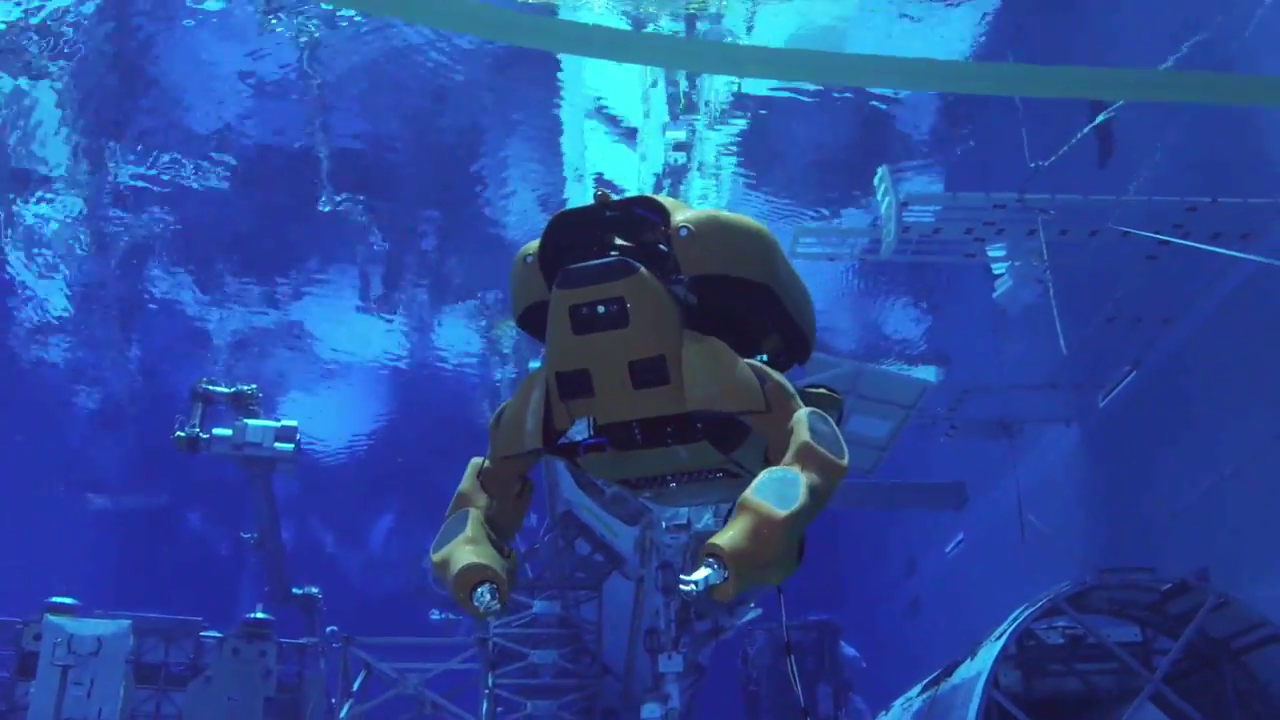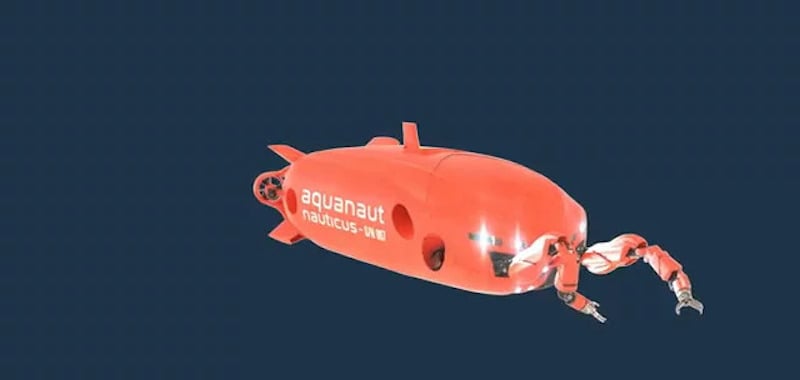The improvement in the solution of industrial problems will derive from technology, innovation and the optimization of resources. The industry has yet to understand and accept the continued benefits to be gained from the power of robotic technology through energy evolution.
Companies manufacturing autonomous robots for the ocean industries are booming, such as Nauticus Robotics, Inc. (formerly Houston Mechatronics) which has a team that includes several former NASA engineers. It is a company that develops robots in order to solve problems in the nautical industry, they use innovative technologies for greater efficiency in aquatic activities. The Aquanaut is here to stay and facilitate special missions that are complex or too dangerous for human divers.
Aquanaut: The First Generation Underwater Transform
I change the shape of the aquatic robots; In 2019, the Aquanaut was introduced to the market, with the purpose of solving challenges in the offshore oil and gas industry, specifically to improve maintenance costs and the safety of underwater operators. Although maintenance of these platforms above water is relatively easy for operators, below water the situation is completely different, as these structures are often complex and extend into depth.
Traditionally, underwater tasks hundreds of meters away are accomplished using Remotely Operated Vehicles (ROVs) attached to a support vehicle where a team of trained human operators oversees operations. Although this approach has been reliable for decades, this type of operation is extremely expensive 1 .
The Aquanaut, an unmanned underwater vehicle designed for long-distance travel, can transform from an agile semi-humanoid robot capable of carrying out complex manipulation tasks. You can inspect subsea oil and gas infrastructure, operate valves, and use tools.
Video courtesy of youtube: https://youtu.be/shimvNXyVtw

His transformation makes him better suited for deep-sea repairs and other tasks, taking just 30 seconds to complete, and begins with the hull separating in one fluid motion, exposing two additional control thrusters, the vehicle’s arms, and adding another degree of freedom to the vehicle’s head mechanism, thus looking like a humanoid; It has two powerful 8-degree-of-freedom arms, while operators monitor the robot without having to directly control it.
This vehicle is fully electric with a high level of autonomy, it does not require support boats as with traditional ROVs. It combines the capabilities of an autonomous underwater vehicle, or AUV, and a remotely operated underwater vehicle, or ROV. When in AUV mode, it can travel long distances of up to 200 km (108 nautical miles) on a mission while mapping its surroundings and conducting structure surveys. In ROV mode, the robot can turn valves, use various underwater tools, and perform other handling tasks. It has a maximum operating depth of 300 meters, its vision and mobility are of high quality.
The device has a width of 152 cm, with a height of 97 cm (closed) and 160 cm (open), its length is 350 cm and a weight of 1050 kg, it can reach a maximum speed of 13 km/h (7 knots), while the vehicle body contains an inertial navigation system, Doppler velocity logs (DVL), machine vision cameras, prospective sonar, scanning sonars, GPS and custom 3D structured light2 .
The robot is packed with live cameras that broadcast its movements to the operators who control the robot in real time. In order to maintain communication with Aquanaut, it is designed with an acoustic modem that allows it to be controlled from anywhere in the world and, furthermore, it is the only way to communicate with the small submarine. https://blogthinkbig.com/submarino-aquanaut-transformer
Working in ROV mode, Aquanaut’s power capacity is expected to last one day (using all imaging systems, arms and its seven thrusters). In AUV mode, the vehicle uses less power, so a more realistic scenario is a combination of both modes, extending mission duration by at least 50%. https://petrobanca.com/aquanaut-robot-submarino-para-la-industria-petrolera-de-noruega-a-partir-de-2022/
Aquanaut Mark 2, a second generation super robot
After the great experience of the Aquanaut, in the year 2023 the underwater robot Aquanaut MK2 arrives in the water, the first of three second-generation robots, which is also fully electric, untethered and autonomous, which is controlled through a network of acoustic communication and is supported by Nauticus’ proprietary software package, toolKITT.
The AI-based software suite enables robotic controls, user interfaces, sensor integration, simulation, data analysis, and communication frameworks built specifically to enable underwater work.
The Aquanaut MK2’s defining ability is to operate in two separate modes, actively transforming between excursion and intervention configurations.

Excursion mode involves the use of perception sensors and data collection, while Intervention mode uses two of Nauticus’ Olympic arms (work-class electrical manipulators) to perform precise yet powerful interactions with infrastructure and objects. submarines to complete complex underwater tasks.
This second-generation Aquanauts series is a major milestone that accelerates the mission to disrupt the offshore ocean service industry, while setting a benchmark for next-generation underwater technology that will fundamentally revolutionize the way the industry operates. . https://www.oedigital.com/news/504348-nauticus-robotics-launches-2nd-gen-aquanaut-subsea-robots
Nauticus develops cloud-based autonomy software to enable a smarter and more sustainable ocean industry by using its fleet of autonomous robots from the surface to the seabed. These robots are enabled by the Nauticus Software Suite, a platform of Artificial Intelligence and Machine Learning technologies designed to disrupt legacy methods in the marine industry.
Autonomous ocean robots and proprietary artificial intelligence software provide a compelling solution for the marine industry, validated on a recurring basis with continued interest and strong growth for users.
It is the world’s first untethered underwater robot capable of robust decision making for both long-distance ocean data collection and close-up dexterous manipulation of the underwater environment, supporting the industry, government and defense sectors. https://www.offshore-energy.biz/nauticus-sea-robots-go-public-with-spac-merger/
This AI-driven technology, along with second-generation underwater robots, substantially improves the efficiency and safety, while reducing the carbon footprint, of offshore operations at significantly reduced costs compared to legacy methods. .
The Aquanaut Mark 2 autonomous underwater robot is supporting Petrobras’ offshore activities in Brazil, and will also be deployed in the North Sea and Gulf of Mexico in the coming months to support customer initiatives in those regions.
Conclusion
The Aquanaut Robot represents an impressive technological advance in the realm of offshore maritime operations. If employed responsibly and challenges around implementation and workforce impact are addressed, underwater robots like the Aquanaut can play a decisive role in the future of deepwater exploration and production, improving efficiency and safety in the industry.
Sources
- https://thenewstack.io/aquanaut-the-shapeshifting-subsea-autonomous-robot/
- https://robotsguide.com/robots/aquanaut
- https://roboticsandautomationnews.com/2023/04/16/nauticus-robotics-launch-new-generation-of-its-aquanauts/66713/

